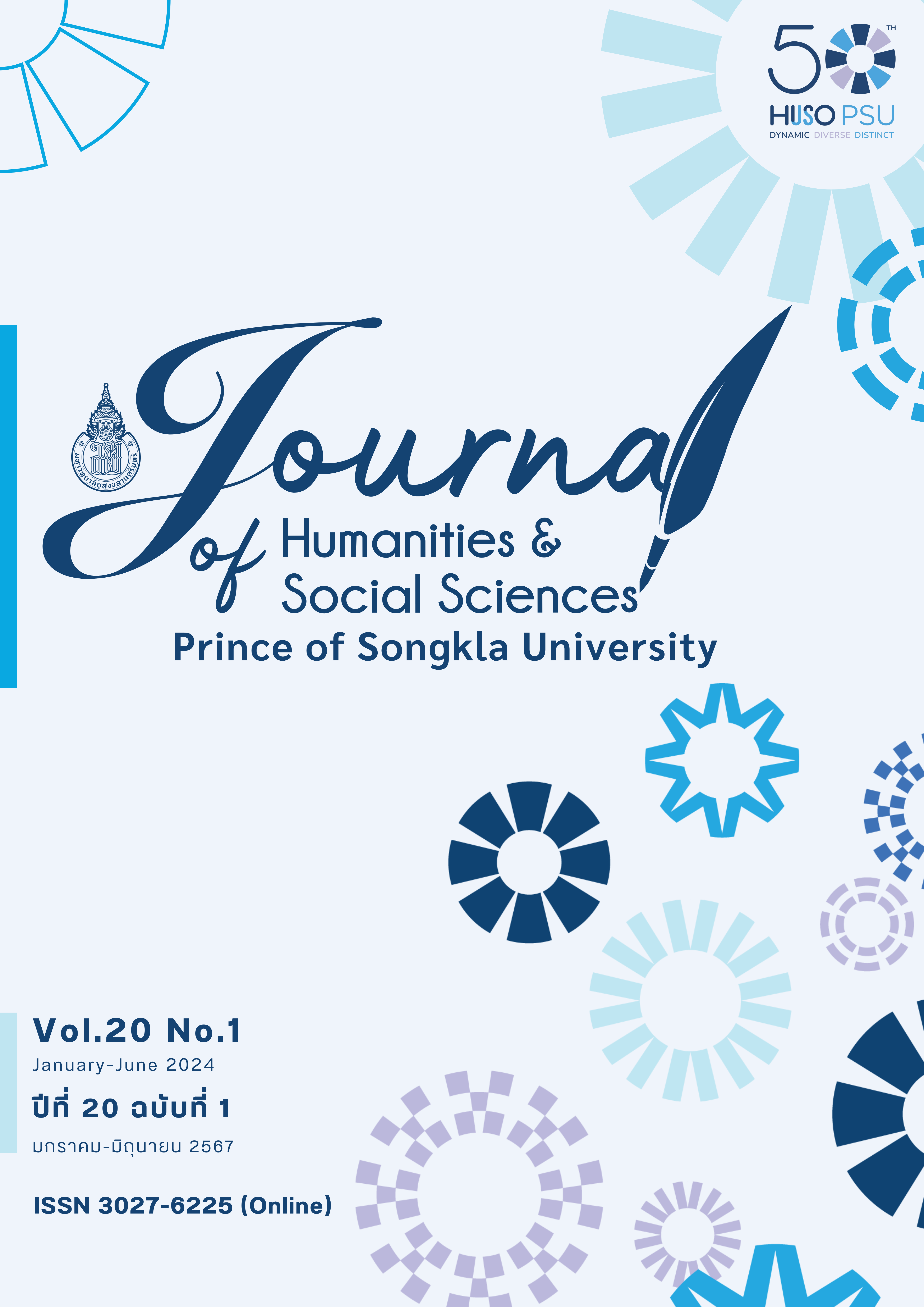THE FACTORS RELATED TO MOTHERS' DECISION TO TERMINATE AN UNWANTED PREGNANCY OF SONGKHLA HOSPITAL, SONGKHLA PROVINCE
Keywords:
decision making, mother, termination of pregnancy, unwanted pregnancyAbstract
This study employs qualitative phenomenological research to explore the factors influencing mothers facing unwanted pregnancies at Songkhla Hospital in Songkhla and their decision-making process regarding termination between December 2022 and February 2023. The study involved eight informants, aged 17 to 42, who chose to terminate unintended pregnancies and were legally allowed to do so. Using a semi-structured interview instrument, experts reviewed the instruments. Data were analyzed through content analysis, categorizing and classifying issues.
According to the study's findings, there are five distinct aspects influencing a mother's decision to terminate her pregnancy and prepare for a new beginning: 1. Physical dimension: mothers with congenital conditions impacting daily life may choose termination and adopt lifelong birth control plans to prevent future pregnancies. 2. Psychological dimension: mothers experiencing agitation and anxiety may undergo behavioral changes leading to depression. They may opt for termination, seeking treatment for depression before considering future pregnancies and using temporary birth control methods. 3. Economic dimension: unemployed mothers or those facing financial constraints may choose termination, aiming to stabilize their financial situation before considering parenthood again. They may opt for temporary birth control, work, and wait until their financial position improves. 4. Educational dimension: student mothers whose pregnancies affect academic performance may choose termination, prioritizing their studies. They may lack the maturity to raise children and return to their studies, using temporary birth control methods. 5. Family and social dimensions: mothers facing family rejection or social stigma may choose termination, utilizing temporary birth control methods and avoiding sexual relationships until they feel socially accepted.
These findings can provide essential insights for mothers contemplating terminating an unwanted pregnancy. Governmental and private agencies can utilize the study's results to develop guidelines supporting mothers seeking pregnancy termination.
References
กนกวรรณ ธราวรรณ. (2548). ทางเลือกของผู้หญิงที่ท้องไม่พร้อม (วิจัย). บริษัทพีเอนพี กรุ๊ป.
กาญจนา บุศรากุล และคณะ. (2546). ปัจจัยที่เกี่ยวข้องกับการทำแท้งในกลุ่มสตรีที่เข้ารับการรักษาในโรงพยาบาลสวรรค์ประชารักษ์. วารสารวิชาการการแพทย์ เขต 8, 11(3), 163-172.
กมลชนก คชฤทธิ์, นุชนาฎ ชิดตะคุ, พิมพ์ภิกา ยะคาป้อ, วลดาวัลย์ จิตขาว, ศุภรานันท์ ยุทธโกวิท,
และกิ่งดาว มะโนวรรณ. (2553). แนวทางการแก้ไขปัญหาการตั้งครรภ์ไม่พึงประสงค์กรณีศึกษา โครงการคุณแม่วัยใสห่วงใยอนาคตศูนย์ฝึกอาชีพสตรี จังหวัดเชียงราย อำเภอพาน จังหวัดเชียงราย. [วิทยานิพนธ์ปริญญามหาบัณฑิต]. มหาวิทยาลัยราชภัฏเชียงราย.
กิ่งมณี กองเงิน. (2543). การศึกษาแนวโน้มของการทำแท้งโดยผิดกฎหมายในระยะเวลา 4 ปี (2539 -2542) ปัจจัยชักนำและทัศนคติต่อการทำแท้งของสตรีที่เข้ารับการรักษาในโรงพยาบาลพุทธชินราช พิษณุโลก. มหาวิทยาลัยนเรศวร.
กิ่งดาว มะโนวรรณ. (2553). แนวทางการแก้ไขปัญหาการตั้งครรภ์ไม่พึงประสงค์: กรณีศึกษาโครงการคุณแม่วัยใสห่วงใยอนาคตศูนย์ฝึกอาชีพสตรีจังหวัดเชียงราย อำเภอพาน จังหวัดเชียงราย. [วิทยานิพนธ์ศิลปศาสตรมหาบัณฑิต]. มหาวิทยาลัยราชภัฏเชียงราย.
กีรติ ลีละพงศ์วัฒนา. (2559). การใช้ยายุติการตั้งครรภ์ (Medical Abortion Pill). สืบค้น23 ธันวาคม, จาก http://haamor.com/th
เกษตรชัย และหีม และประไพ สุวรรณสุนทร. (2558). ผลกระทบทางสังคมจากการตั้งครรภ์ก่อนวัยอัน ควรของหญิงวัยรุ่นในอําเภอนาหม่อม จังหวัดสงขลา. วารสารพัฒนบริหารศาสตร์, 55(1), 130-152.
ไทยรัฐฉบับพิมพ์. (2560). สถิติทำแท้ง 29% เป็นนักเรียน นักศึกษา. สืบค้น 3 ธันวาคม 2565, จาก https://www.thairath.co.th/content/868386
ธนพันธ์ ชูบุญ. (2549). การสิ้นสุดการตั้งครรภ์: Terminal of pregnancy. (อ้างอิงใน อุ่นใจ กออนันตกุล, บรรณาธิการ, 2549) การตั้งครรภ์ความเสี่ยงสูง: High risk pregnancy. คณะแพทยศาสตร์ มหาวิทยาลัยสงขลานครินทร์.
นภาภรณ์ หะวานนท์. (2539). การตั้งครรภ์ไม่พึงประสงค์และการยุติการตั้งครรภ์:ประเด็นท้าท้ายนโยบายการให้บริการของรัฐ. วารสารการสถาบันวิจัยระบบสาธารสุข, 4(1), 45-54.
นิศานาถ สรรคพงษ์ และพนมพร พุ่มจันทร์. (2560). การตัดสินใจเก็บครรภ์และการดำเนินชีวิตของสตรีที่เก็บครรภ์ไม่พึงประสงค์. วารสารสังคมศาสตร์และมนุษยศาสตร์ มหาวิทยาลัยเกษตรศาสตร์, 43(1), 161-192.
ปราณี โพธิ์สุพรรณ์. (2551). กรณีศึกษา:การพยายาบาลครอบครัวที่มีสมาชิกทำแท้งผิดกฎหมาย. [รายงานการศึกษาอิสระปริญญาพยาบาลศาสตรมหาบัณฑิต]. มหาวิทยาลัยขอนแก่น.
พระราชบัญญัติป้องกันและแก้ไขปัญหาการตั้งครรภ์ในวัยรุ่น. (2559).ราชกิจจานุเบกษา. เล่มที่ 133,ตอนที่ 30. สืบค้น 3 ธันวาคม 2565, จาก https://new.camri.go.th/infographic/31
พีระยุทธ สานุกูล. (2563). กรมอนามัยร่วมกับไบเออร์ไทย รณรงค์สังคมไทยหยุดท้องไม่พร้อม สนับสนุนการตั้งครรภ์อย่างมีคุณภาพในวันคุมกำเนิดโลก. สืบค้น 2 ธันวาคม 2565, จาก https://www.bayer.com/th/th/thailand-bayer-thai-join-the-campaign-
to-prevent-unintended-pregnancies?fbclid=IwAR2ZAD0ieaLombDAy-GqSfXwyPsKBrRHcMNhq2 CHwQLso8y-FA_ZZlo1kw
ระวีวรรณ พิไลยเกียรติ, และอุทุมพร แหลมหลวง. (2563). ประสบการณ์ด้านจิตวิญญาณของหญิงตั้งครรภ์ความเสี่ยงสูง. วารสารสภาการพยาบาล, 35(3), 121-138.
วรพจน์ บุษราคัมวดี. (2551). องค์การและการจัดการ. มหาวิทยาลัยวไลยอลงกรณ์ในพระบรมราชปถัมภ์.
วิอร โสมินทุ. (2559). การยุติการตั้งครรภ์: มุมมองของบุคลากรทางการศึกษา. วารสารบริหารการศึกษามหาวิทยาลัยศิลปากรม, 7(1), 248-257.
ศศินันท์ พันธุ์สุวรรณ, พัชรินทร์ สังวาล, อิชยา มอญแสง, และพัชรินทร์ ไชยบาล. (2556). ประสบการณ์หลังตั้งครรภ์วัยรุ่นที่ไม่ได้แต่งงานในภาคเหนือตอนบน. วารสารพยาบาลสงขลานครินทร์, 33(3), 17-35.
ศิริพร จิรวัฒน์กุล. (2553). การวิจัยเชิงคุณภาพด้านวิทยาศาสตร์สุขภาพ. บริษัทวิทยพัฒน์.
สุกัญญา อ่อนจู. (2552). ปัจจัยที่มีอิทธิพลต่อพฤติกรรมการมีเพศสัมพันธ์ก่อนวัยอันควรและการมีเพศสัมพันธ์ที่ไม่ปลอดภัยของหญิงตั้งครรภ์ : กรณีศึกษาหญิงตั้งครรภ์วัยรุ่น ตำบลหนองโสน อำเภอสามง่าม จังหวัดพิจิตร. [วิทยานิพนธ์สาธารณสุขศาสตร์บัณฑิต]. มหาวิทยาลัยนเรศวร.
สุชาดา รัชชกุล. (2541). การตั้งครรภ์ไม่พึงปรารถนาและการตัดสินใจทำแท้ง. [วิทยานิพนธ์ปริญญาโท]. มหาวิทยาลัยศรีนครินทรวิโรฒประสานมิตร.
สมพิศ ใยสุ่น, และปรียารัตน์ รัตนวิบูลย์. (2554). รายงานการวิจัยรูปแบบการสร้างเสริมพฤติกรรมการ ป้องกันการตั้งครรภ์ไม่พึงประสงค์แก่นักเรียนชั้นมัธยมศึกษาปีที่ 3 โรงเรียนศึกษาสงเคราะห์ กระทรวงศึกษาธิการ. วิทยาลัยพยาบาลสภากาชาดไทย.
สมสุข โสภาวนิตย์, สุภาพร สมบัติ, และอารีรัตน์ จันทร์ลาภู. (2562). รายงานเฝ้าระวังการแท้งประเทศไทย พ.ศ.2562. สำนักอนามัยการเจริญพันธุ์ กรมอนามัย กระทรวงสาธารณสุข. จาก https://rh.anamai .moph.go.th/web-upload/migrated/files/rh/n330_d1a80b22d8a4daa876f459095915af6d_Ebook_Abortion_62.pdf
สำนักงานสถิติจังหวัดสงขลา. (2561). รายงานสถิติจังหวัดสงขลา. สำนักงานสถิติจังหวัดสงขลา.
สำนักอนามัยการเจริญพันธุ์ กรมอนามัย กระทรวงสาธารณสุข. (2557). คู่มือแนวทางปฏิบัติการดูแลหญิง. กองทุนประชากรแห่งสหประชาชาติ.
สำนักอนามัยเจริญพันธุ์ กรมอนามัย กระทรวงสาธารณสุข. (2558). คู่มือการจัดกิจกรรมเรื่องเพศคุยได้
ในครอบครัว. (พิมพ์ครั้งที่ 2). ศูนย์สื่อและสิ่งพิมพ์แก้วเจ้าจอม.
สำนักอนามัยเจริญพันธ์ กรมอนามัย กระทรวงสาธารณสุข. (2561). รายงานประจำปี 2561.
สำนักอนามัย การเจริญพันธุ์. สืบค้น 8 มกราคม 2562, จาก http://rh.anamai. moph. go.th/ewt_dl_link. php?nid=263
สำนักอนามัยเจริญพันธ์ กรมอนามัย กระทรวงสาธารณสุข. (2562). สถานการณ์การตั้งครรภ์แม่วัยรุ่น. สืบค้น 5 พฤศจิกายน 2563, จาก http://rh.anamai.moph.go.th/download/all_file/ index/situation/ FactSheet@62.pdf
โสเพ็ญ ชูนวล, จิตไส ลาวัลย์ตระกูล, ครีพจนารถม วัฒนา, ศิริรัตน์ โกศัลวัฒน์, จิตติ ลาวัลย์ตะกูล,อวยพร สมใจ, อรมิช แสงจันทร์, และจิตรานันท์ ลมพร. (2554). รายงานผลการวิจัยการศึกษาสถานการณ์แท้งในภาคใต้ของประเทศไทย. คณะพยาบาลศาสตร์ มหาวิทยาลัยสงขลานครินทร์.
องค์การยูนิเซฟ ประเทศไทย. (2559). รายงานผลการวิจัยเพื่อทบทวนการสอนเพศวิถีศึกษาในสถาน ศึกษาไทย. สืบค้น 27กุมภาพันธ์ 2564, จาก https://www.unicef.org/thailand/media/ 1106/file/รายงานผลการวิจัยเพื่อทบทวนการสอนเพศวิถีศึกษาในสถานศึกษาไทย.pdf
อาภรณ์ ดีนาน. (2551). แนวคิด และวิธีการส่งเสริมสุขภาพวัยรุ่น. ไฮเดนกรุ๊ป.
Athey, J., & Spielvogel, A. (2000). Risk factors and interventions for psychological sequelae in women after miscarriage. Primary Care Update for Obstetrics Gynecology, 7(2), 64-69.
Cohen, MZ, Kahn, DL, & Steeves, RH. (2000). Hermeneutic phenomenological research: a practice guide for nurse researchers. Sage.
Dallas, C. M. (2009). Interactions between adolescent fathers and health care professionals during pregnancy, labor, and early postpartum. Journal of obstetric. Gynecologic, & Neonatal Nursing, 38(3), 290-299.
Feldman-Winter, L., & Shaikh, U. (2007). Optimizing breastfeeding promotion and support in adolescent mothers. Journal of Human Lactation, 23(4), 362-367.
Grassley, J. S. (2010). Adolescent mothers’ breastfeeding social support needs. Journal of Obstetric. Gynecologic, & Neonatal Nursing, 39(6), 713-722.
Green, C. J., & Wilkinson, J. M. (2012). Maternal newborn nursing care plan (2 nd ed). Mosby.
Herrman, Judith. (2006). The Voices of Teen Mothers. (The Experience of Report Pregnancy, MCN). The American Journal of Maternal / Child Nursing, 31(4), 243-249.
Koetsawang, Suporn. (1993). lllegally induced Abor- tion In Thailand. [Paper presented] IPPF SEAO Regional Programme Advisory Panel Meeting on Abortion. 29-30 October 1993, Bali, Indonesia.
Pinotti & Faundes. (1989). Unwanted pregnancy: challenges for health policy. Retrieved May 11, 2021. from https://obgyn.onlinelibrary.wiley.com.
Prasitlumkum, M. (2009). Risk of low birth weight and adverse pregnancy outcomes in adolescent pregnancies at chainat hospital. Thai Journal of Obstetrics and Gynecology, 17(2), 93-97.
UNICEF Thailand. (2015). Situation Analysis of Adolescent Pregnancy in Thailand. Retrieved May 20, 2017, from https://www.unicef.org/thailand/media/1126/file/ Situation Analysis of Adolescent Pregnancy in Thailand.pdf
WHO. (2018). Adolescent pregnancy. Retrieved May 20, 2017, from http://www.who. int/news-room/fact-sheets/detail/adolescent-pregnancy
Downloads
Published
How to Cite
Issue
Section
License
Copyright (c) 2024 Journal of Humanities and Social Sciences Prince of Songkla University

This work is licensed under a Creative Commons Attribution-NonCommercial-NoDerivatives 4.0 International License.
บทความนี้ได้รับการตีพิมพ์เป็นของวารสารวิชาการคณะมนุษยศาสตร์และสังคมศาสตร์ คณะมนุษยศาสตร์และสังคมศาสตร์ มหาวิทยาลัยสงขลานครินทร์ วิทยาเขตปัตตานี






